Overview
The article “Mastering Banking Digital Transformation: A Step-by-Step Guide” addresses the critical need for financial institutions to adeptly navigate and implement digital transformation strategies that enhance operations and elevate customer experiences. It posits that successful digital transformation is not a one-time effort but a continuous journey, requiring the adoption of innovative technologies and fostering collaboration across departments.
Furthermore, it strategically tackles challenges such as outdated systems and regulatory pressures. This underscores the importance of adaptability and the necessity for ongoing investment in technology, which are essential for sustainable growth.
Are you ready to embark on this transformative journey?
Introduction
In the rapidly evolving landscape of banking, digital transformation is no longer a choice but a necessity. Financial institutions are compelled to enhance customer experiences and streamline operations, increasingly integrating advanced technologies into their core functions. This comprehensive shift not only redefines how banks interact with customers but also optimizes internal processes, enabling agility in a competitive market.
How can banks harness the power of artificial intelligence, adopt cloud solutions, and leverage blockchain technology to stay ahead? The journey of digital transformation is multifaceted and ongoing. As banks face mounting pressures from regulatory changes and rising operational costs, understanding the strategic approaches and collaborative efforts necessary for successful implementation becomes paramount.
This article delves into the critical components of digital transformation in banking, exploring key technologies, successful case studies, and the future trends that will shape the financial sector. What steps will your institution take to embrace this transformation?
Understanding Digital Transformation in Banking
The thorough incorporation of digital technologies throughout all operational aspects signifies a banking digital transformation, fundamentally altering how banks operate and provide value to their clients. This evolution is propelled by the imperative to enhance customer experiences, boost operational efficiency, and remain agile in a rapidly evolving financial landscape. Key components of this change include:
- The adoption of innovative technologies
- A reevaluation of traditional business models
- The cultivation of a culture that embraces innovation
Avato, with its dedicated hybrid integration platform, plays a crucial role in this transformation by simplifying the integration of disparate systems and enhancing business value. In 2025, the influence of artificial intelligence (AI) and machine learning on user experience is anticipated to be profound. These technologies allow financial institutions to provide tailored services, optimize processes, and ultimately improve client satisfaction and loyalty.
For example, AI-driven analytics can provide insights into customer behavior, allowing financial institutions to tailor their offerings and improve engagement.
Current trends indicate that financial institutions are increasingly focusing on banking digital transformation to tackle the challenges posed by rising operational costs and regulatory pressures. As European financial institutions encounter a scenario where cost growth is anticipated to outpace revenue growth, there is a pressing need for stronger cost discipline and strategic investments in technology. Avato’s hybrid integration solutions empower financial institutions to lead the AI revolution, optimizing existing operations while unlocking new growth opportunities, particularly in sectors like wealth management, where competition is intensifying.
Despite top banks holding only a 32% market share in wealth management, increasing competition and regulatory scrutiny on fees present challenges for growth, highlighting the need for innovation in this area.
Successful changes in banking digital transformation illustrate the potential for innovation to drive significant improvements. Institutions that have embraced banking digital transformation report enhanced operational capabilities and a more agile response to market demands. Furthermore, statistics reveal that 71% of clients are more likely to trust a company with their personal data if its use is clearly explained, underscoring the importance of transparency in building trust during this transformation.
As Salesforce notes, ‘71% of individuals are more likely to trust a company with their personal data if its use is clearly explained.’
As banks navigate this complex landscape of banking digital transformation, they must implement new technologies by carefully selecting vendors, launching pilot programs, and scaling successful solutions throughout the organization. By utilizing Avato’s hybrid integration platform, they can effectively harness the power of digital technologies to not only enhance their operations but also to create a more connected and satisfying user experience.
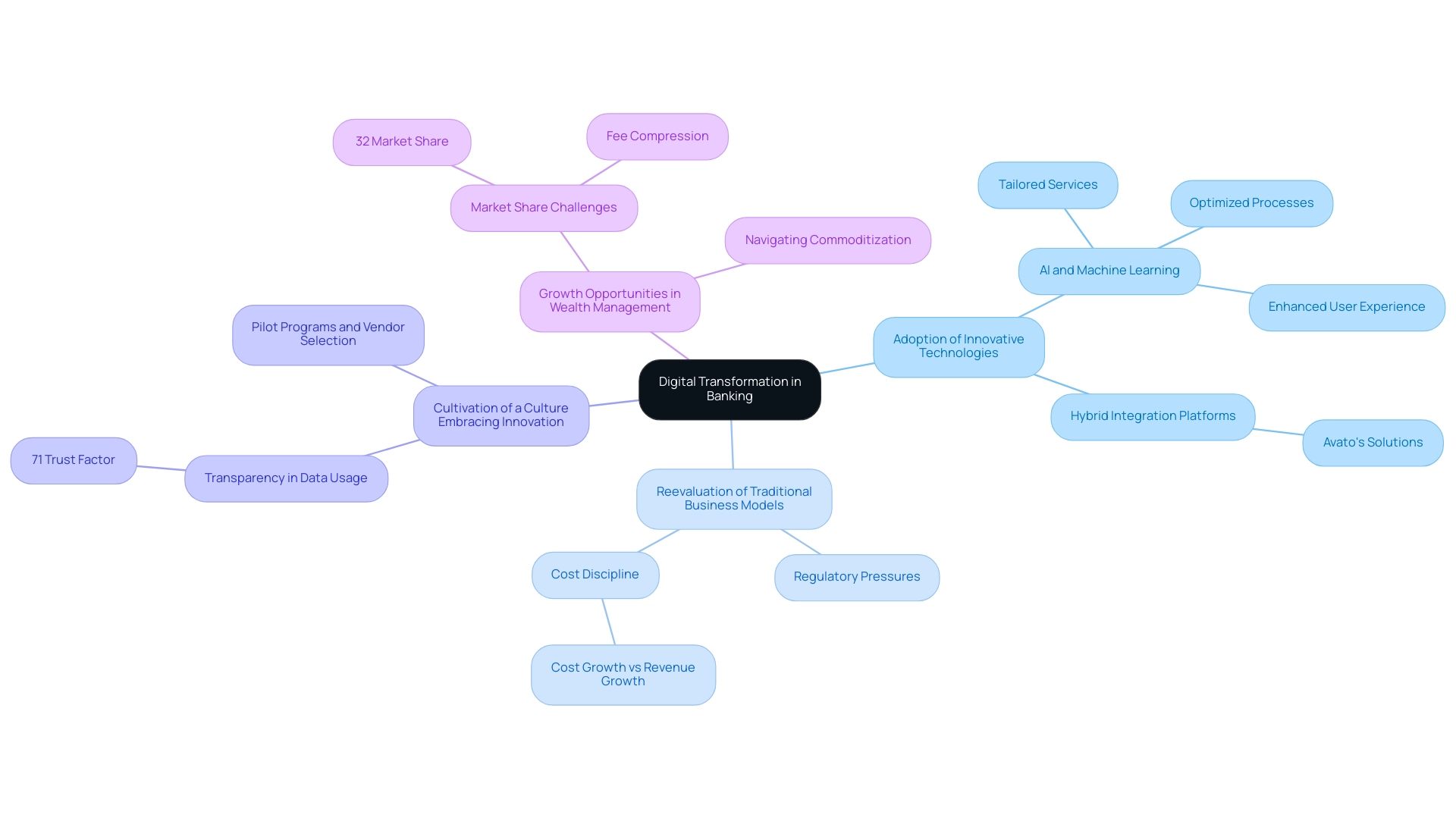
Digital Transformation: An Ongoing Journey, Not a Project
Banking digital transformation should not be perceived as a finite project with a definitive endpoint; it is, in fact, an ongoing journey that necessitates continuous adaptation to emerging technologies, evolving customer expectations, and shifting regulatory landscapes. This mindset cultivates a culture of regular strategy assessment, investment in new capabilities, and openness to innovation. For instance, a significant percentage of financial institutions are adopting agile methodologies—estimated at around 40% in 2025—allowing them to swiftly adjust their strategies in response to real-time feedback and market dynamics.
This agility is crucial for maintaining relevance in an increasingly competitive environment.
Furthermore, as financial institutions navigate the complexities of a low-growth macroeconomic landscape, characterized by challenges such as declining net interest income and high deposit costs, they must make strategic decisions regarding their interest income strategies and asset-liability management. Ongoing banking digital transformation is essential for effectively tackling these challenges. The case study titled “Challenges for Banks in a Low-Growth Environment” highlights that banks are facing significant issues, including sluggish growth in consumer loans and high deposit costs, which are expected to remain elevated despite falling interest rates.
Institutions embracing continuous change not only enhance operational efficiencies but also improve customer satisfaction by delivering tailored services that meet modern demands.
Acknowledging and rewarding contributions to technological advancement efforts can further inspire employees, nurturing a culture of innovation and adaptability. As banking executives increasingly expect efficiencies from technologies like generative AI—38% anticipate cost reductions—it’s clear that the commitment to ongoing banking digital transformation is vital for sustainable growth and competitiveness in the financial services sector.
With Avato’s comprehensive hybrid integration services, including enterprise architecture, software development, project management, and partnerships, financial institutions can leverage advanced technologies to streamline operations and enhance customer engagement. Avato’s services specifically facilitate the integration of AI technologies, enabling banks to harness insights from the NVIDIA survey effectively. Gustavo Estrada from BC Provincial Health Services Authority remarked, “Avato has the capability to simplify intricate projects and provide outcomes within preferred timelines and financial limits,” emphasizing the significance of efficient electronic change strategies.
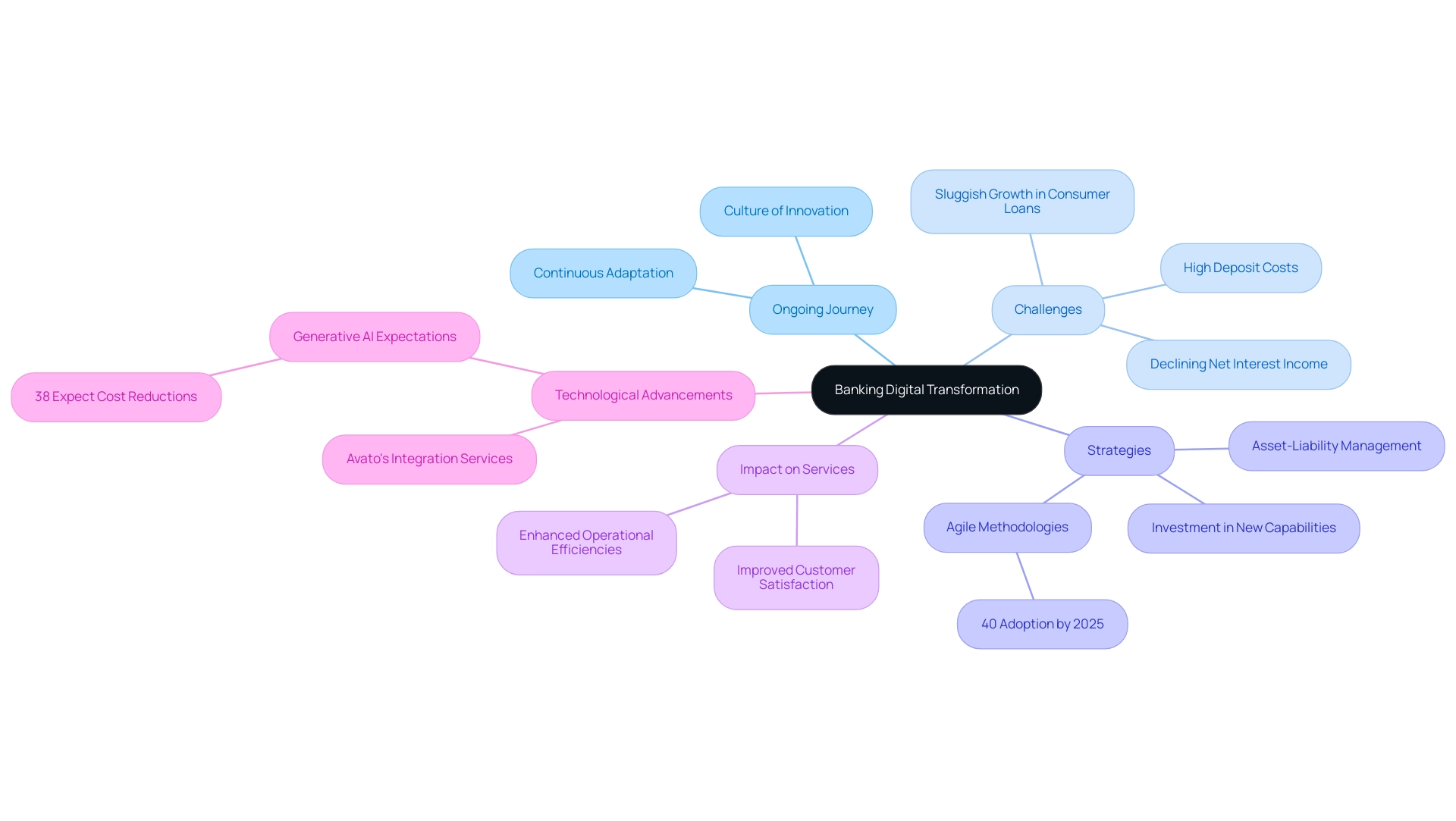
The Collaborative Nature of Digital Transformation
Successful banking digital transformation hinges on efficient cooperation among various departments, such as IT, operations, marketing, and customer service. By cultivating a culture of teamwork, financial institutions can leverage diverse perspectives and expertise, which are vital for driving innovation. For instance, cross-functional teams can collaborate to develop customer-centric solutions that significantly enhance the overall banking experience.
Statistics reveal that organizations employing cross-functional teams are 30% more likely to achieve their transformation objectives. This underscores the necessity of regular communication and shared goals, which are essential for ensuring that all departments remain aligned and focused on common aims.
Expert insights emphasize that collaboration not only nurtures innovation but also accelerates banking digital transformation through the implementation of new technologies. By 2025, financial institutions prioritizing cross-departmental collaboration will likely enjoy improved operational efficiency and heightened client satisfaction as a result of banking digital transformation.
Case studies illustrate the efficacy of this approach; for example, a leading bank established cross-functional teams to enhance its identity verification process, resulting in a 60% increase in the use of biometric methods for client authentication. This not only bolstered security but also enriched the client experience, showcasing the tangible benefits of collaborative efforts in banking digital transformation. Gustavo Estrada, a customer, remarked, “Avato has simplified complex projects and delivered results within desired time frames and budget constraints,” highlighting the effectiveness of collaboration in achieving successful outcomes.
Additionally, Tony Leblanc from the Provincial Health Services Authority stated, “Good team. Good people to work with. Extremely professional. Extremely knowledgeable,” further underscoring Avato’s commitment to excellence.
As asset and liability management committees navigate the complexities of balancing loan and deposit rates amid macroeconomic shifts, the role of collaboration becomes increasingly critical. With 54% of IT experts citing a shortage of specialized skills as a significant barrier to technological change, harnessing the strengths of cross-functional teams is essential for fostering innovation and adapting to evolving market demands. Avato accelerates the integration of isolated systems and fragmented data, providing the connected foundation enterprises require to simplify, standardize, and modernize.
This ensures a successful digital transformation journey, especially in the face of evolving challenges. To effectively mobilize stakeholders and model business processes, organizations can leverage Avato’s hybrid integration platform features, which support 12 levels of interface maturity, balancing the speed of integration with the sophistication necessary to future-proof technology stacks.
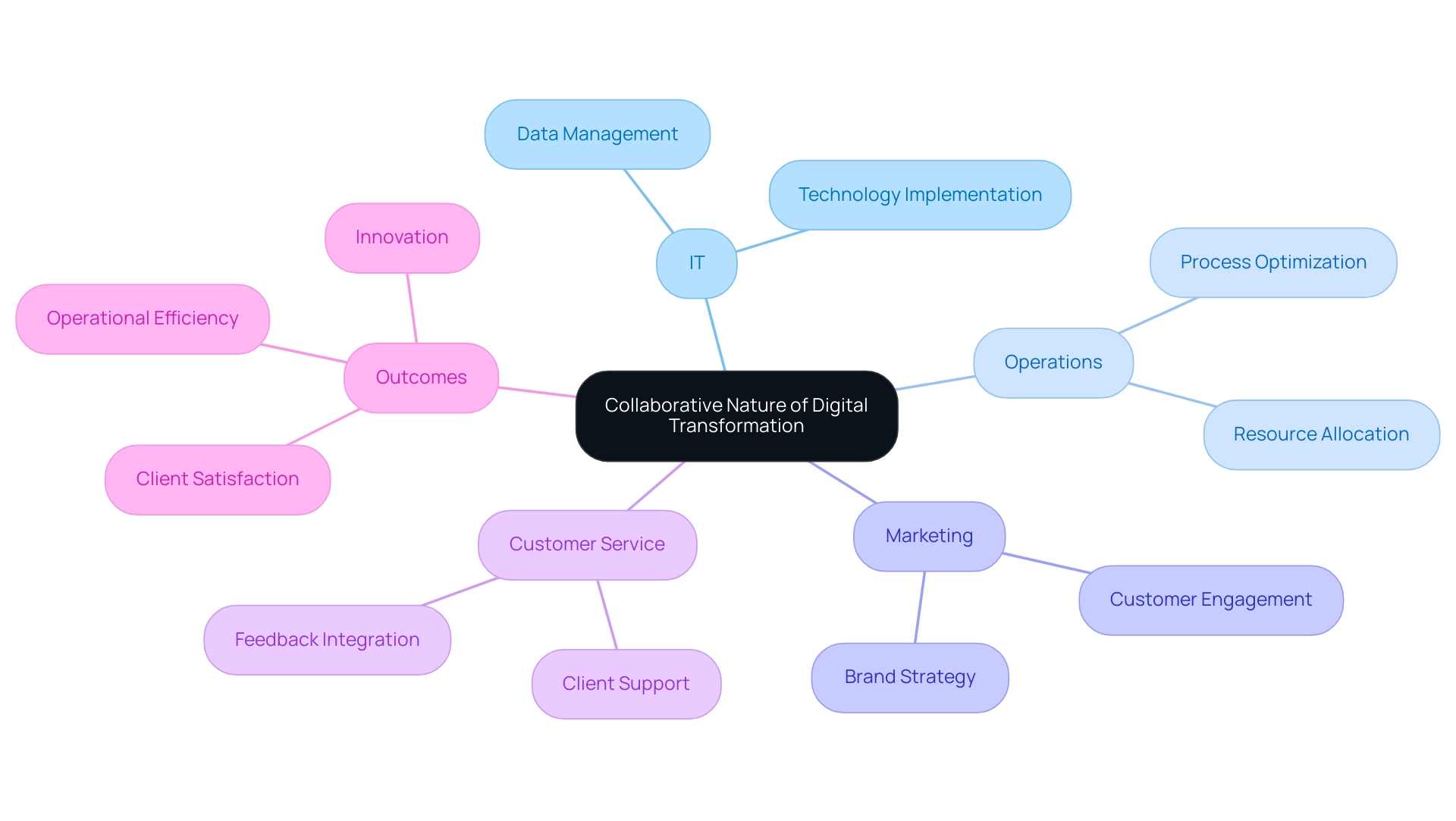
Key Technologies Driving Digital Transformation
Banking digital transformation is significantly influenced by several pivotal technologies, notably artificial intelligence (AI), cloud computing, blockchain, and robotic process automation (RPA). AI enables financial institutions to sift through extensive datasets, allowing them to customize client experiences and enhance decision-making processes. In fact, as of 2025, the adoption of AI in banking is projected to reach 80%, underscoring its critical role in enhancing operational capabilities.
The rise of generative AI, particularly in user experience, has seen a 60% increase in its use for developing sophisticated chatbots and virtual assistants, showcasing its transformative potential.
Cloud computing stands out for its scalability and flexibility, allowing financial institutions to swiftly respond to evolving market demands and user expectations. This adaptability is crucial as financial institutions increasingly prioritize banking digital transformation in their services. Furthermore, blockchain technology is revolutionizing transaction security and transparency, addressing growing concerns over data integrity and fraud. RPA complements these advancements by automating repetitive tasks, which not only boosts operational efficiency but also frees up human resources for more strategic initiatives.
The combination of these technologies can result in considerable cost savings and enhanced satisfaction among clients as financial institutions pursue banking digital transformation to optimize their procedures and improve service provision.
To demonstrate the effect of these technologies, consider a case study where a prominent financial organization adopted AI-driven analytics to tailor interactions with clients. This initiative resulted in a 30% increase in customer engagement and a notable rise in satisfaction scores. Similarly, another institution leveraged cloud solutions to enhance its service offerings, achieving a 25% reduction in operational costs within the first year.
These instances emphasize how Avato’s Hybrid Integration Platform, with its strong integration features and security protocols, can speed up technological change through secure and effective system integration.
As the financial sector progresses towards banking digital transformation and sustainable finance, with major financial institutions pledging to net-zero emissions by 2050, the incorporation of these technologies will be crucial in promoting efficiency and innovation. However, addressing challenges such as skill gaps and resistance to change will be essential for successful implementation. Research from BCG indicates that 70% of technology changes fail due to a lack of employee involvement and resistance during the implementation process.
Furthermore, 71% of clients are more inclined to trust a company with their personal information if its use is clearly detailed, emphasizing the importance of openness in data application, especially concerning AI and customer confidence.
By concentrating on these essential technologies and employing strategies such as establishing clear objectives, engaging staff at every phase, and tackling skill deficiencies, financial institutions can manage the intricacies of technological change and position themselves for sustained success in a progressively competitive environment. For a deeper understanding of these strategies and how arvato can assist in your online change journey, refer to our comprehensive white paper.

Strategic Approaches to Implementing Digital Transformation
To execute banking digital transformation effectively, financial institutions must adopt a strategic approach that encompasses comprehensive planning, robust stakeholder engagement, and ongoing evaluation. This process begins with defining clear objectives that align with the bank’s vision and assessing current capabilities to identify critical gaps. Involving stakeholders from different departments is crucial, as it promotes collaboration and guarantees that the initiative aligns with the overall objectives of the organization.
Statistics indicate that 26% of senior executives see high costs as a major obstacle to technological change, underscoring the need for a unified approach. Furthermore, with European financial institutions anticipated to experience cost increases outpacing revenue growth, the necessity for efficient banking digital transformation strategies becomes even more evident.
Creating metrics to assess progress and success is essential, allowing banks to make informed adjustments throughout the change process. A phased implementation strategy, as advocated by Avato, can effectively mitigate risks and facilitate iterative improvements. This strategy involves breaking down the change process into manageable phases, allowing for continuous feedback and adjustments, which enhances adaptability and reduces the likelihood of significant disruptions.
Consider the case study of Flow, which illustrates how a no-code workflow automation tool can streamline processes, enabling organizations to shift from manual operations to automated systems without disrupting current workflows. This approach not only improves efficiency but also facilitates a smooth transition. As Gustavo Estrada from BC Provincial Health Services Authority noted, ‘Aviator has the ability to simplify complex projects and deliver results within desired time frames and budget constraints,’ highlighting Aviator’s role in ensuring that integration projects are executed smoothly and effectively.
Moreover, guaranteeing a uniform user experience across different corporate web applications utilized by financial institutions is essential for successful digital change. Avato’s hybrid integration platform accelerates secure system integration, particularly in banking, healthcare, and government sectors, enhancing operational visibility and issue resolution. As financial institutions look toward 2025, the emphasis on banking digital transformation and stakeholder engagement will be paramount.
Success stories from the industry emphasize that organizations prioritizing collaboration and communication during their change efforts are more likely to achieve their desired outcomes. By adopting strategic methods that incorporate stakeholder insights and leveraging Avato’s capabilities, financial institutions can navigate the complexities of technological change while maintaining a competitive advantage in an evolving economic landscape.
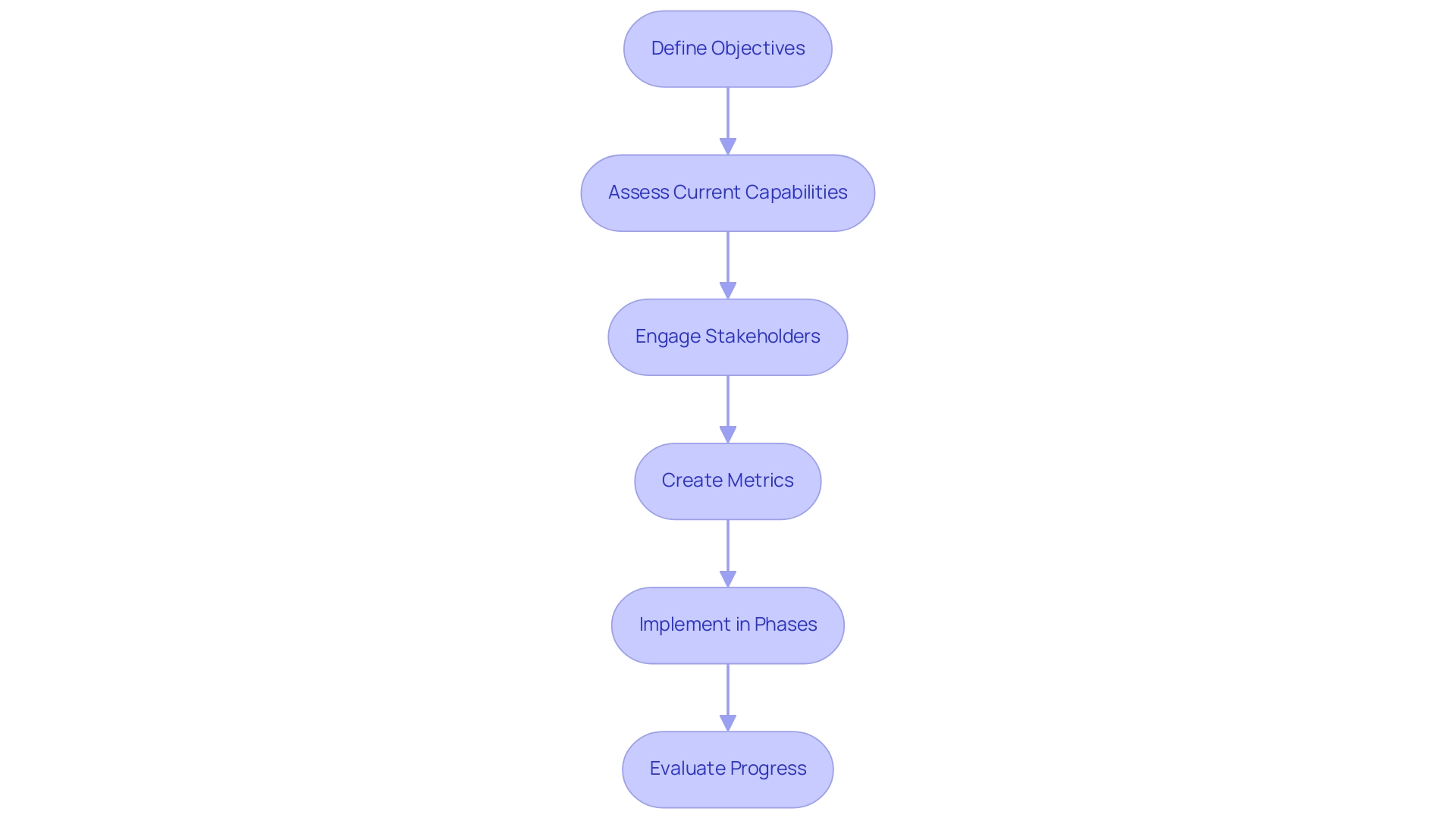
Overcoming Challenges in Digital Transformation
Banks encounter a multitude of challenges during their digital transformation journeys, particularly concerning outdated legacy systems, resistance to change, and urgent cybersecurity threats. As Michael Barr, Federal Reserve Vice Chair, pointed out, significant changes to the original proposal underscore the complexities involved. To effectively navigate these obstacles, institutions must prioritize the modernization of their technology infrastructure, foster a culture of innovation, and implement robust security measures as integral components of their digital transformation. Notably, by 2023, over 60 countries had either embraced or were in the process of adopting open banking regulations, illustrating a global shift towards more integrated financial services.
This evolving regulatory landscape compels financial institutions to adopt digital transformation strategies to upgrade their systems, ensure compliance, and enhance customer experiences. Key challenges include:
- Competing priorities
- Skill gaps
- Resistance to change
- Leadership hurdles
- Technological barriers
- Data security issues
One effective strategy is the adoption of Avato’s hybrid integration platform, which facilitates the seamless integration of legacy systems with emerging technologies. This approach empowers financial institutions to maximize their existing assets while embracing innovation, ultimately reducing costs and enhancing operational capabilities.
Avato, derived from the Hungarian word for ‘of dedication,’ exemplifies a commitment to architecting technology solutions that enable banks to future-proof their operations through seamless data and system integration. Successful players in the digital banking sector are those adept at integrating open banking APIs while maintaining client trust and regulatory compliance, as evidenced by recent case studies within the industry. These entities adeptly navigate regulatory complexities and cybersecurity threats while seizing opportunities for enhanced customer experiences and financial inclusion.
Moreover, addressing the human element is paramount. Providing comprehensive training and support to employees can significantly alleviate resistance to change, cultivating a more agile and adaptable workforce. By equipping personnel with essential skills and knowledge, financial institutions can create an environment conducive to innovation and transformation. Avato’s platform also aids in mobilizing stakeholders to accurately capture requirements and design new business processes, ensuring a smoother transition during technological change.
In summary, tackling the challenges of technological change in banking digital transformation necessitates a multifaceted approach that includes modernizing legacy systems, embracing regulatory changes, and investing in employee development. By leveraging Avato’s unique value proposition of delivering speed, security, and simplicity in integration, financial institutions can position themselves to excel in an increasingly competitive landscape.
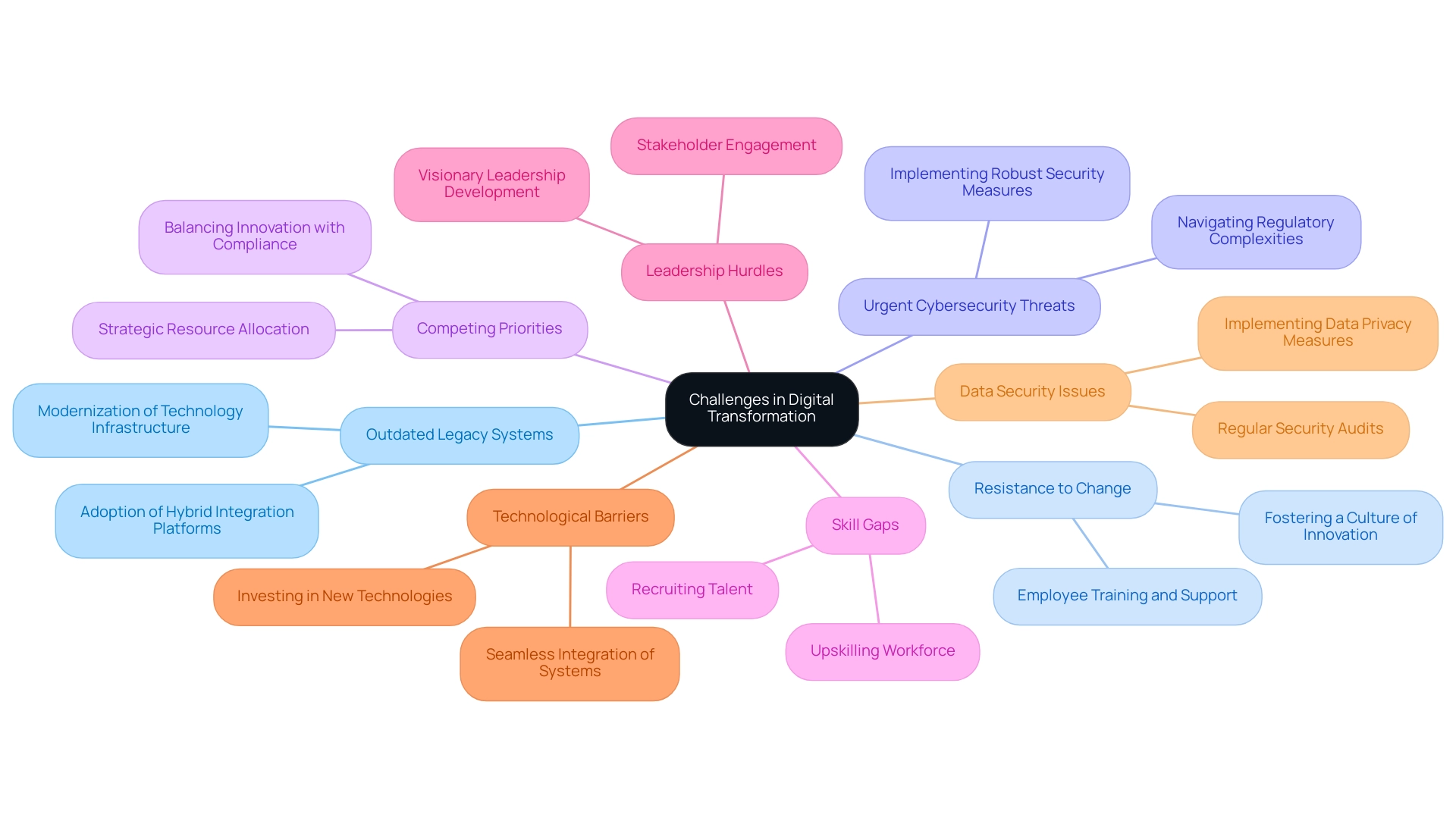
Enhancing Customer Experience Through Digital Transformation
Improving client experience is a pivotal objective of banking digital transformation in the sector. By utilizing advanced technologies, financial institutions can create tailored experiences that cater to the distinct requirements of each client. For instance, the deployment of AI-driven chatbots, a significant application of generative AI, enables 24/7 support—ensuring that help is always available.
These chatbots not only enhance service availability; they also utilize machine learning to improve interactions over time, leading to more effective resolutions. Recent case studies reveal a 60% increase in the use of generative AI for enhancing experiences, underscoring its growing importance in the financial services landscape.
Data analytics plays a crucial role in banking digital transformation, allowing banks to gain insights into preferences and behaviors. By examining transaction patterns and feedback, financial institutions can customize their offerings, ensuring that products and services align with client expectations. This level of personalization is increasingly important, as statistics reveal that 79% of financial customers are willing to spend more for convenience—highlighting the demand for seamless banking digital transformation experiences. Moreover, streamlining processes such as account opening and loan applications can significantly elevate customer satisfaction.
By reducing the time and complexity involved in these transactions, financial institutions not only enhance operational efficiency but also foster stronger relationships with their clients. As Michael J. Hsu observed, some banks may “feel like hostages” to their legacy technology, which highlights the challenges encountered in banking digital transformation. Avato accelerates the integration of isolated systems and fragmented data, delivering the connected foundation enterprises need to simplify, standardize, and modernize their operations.
Incorporating risk controls early in banking digital transformation initiatives not only reduces potential compliance issues but also enhances the overall client experience by ensuring that new technologies are implemented securely and efficiently.
As we look toward 2025, the emphasis on AI-driven client support will only intensify. Banks that adopt these technologies will likely see enhanced client engagement and loyalty, as personalized interactions become the norm. The impact of AI-driven chatbots on customer support is expected to be profound, with financial institutions leveraging these tools to provide timely and relevant assistance—ultimately transforming the customer service landscape in the financial sector.
Moreover, with European financial institutions anticipated to experience expense increases outpacing income growth, the necessity for implementing technological advancement strategies becomes increasingly vital. Avato’s commitment to delivering innovative solutions has been echoed by clients, with testimonials highlighting the effectiveness of their integration strategies in overcoming legacy system challenges.
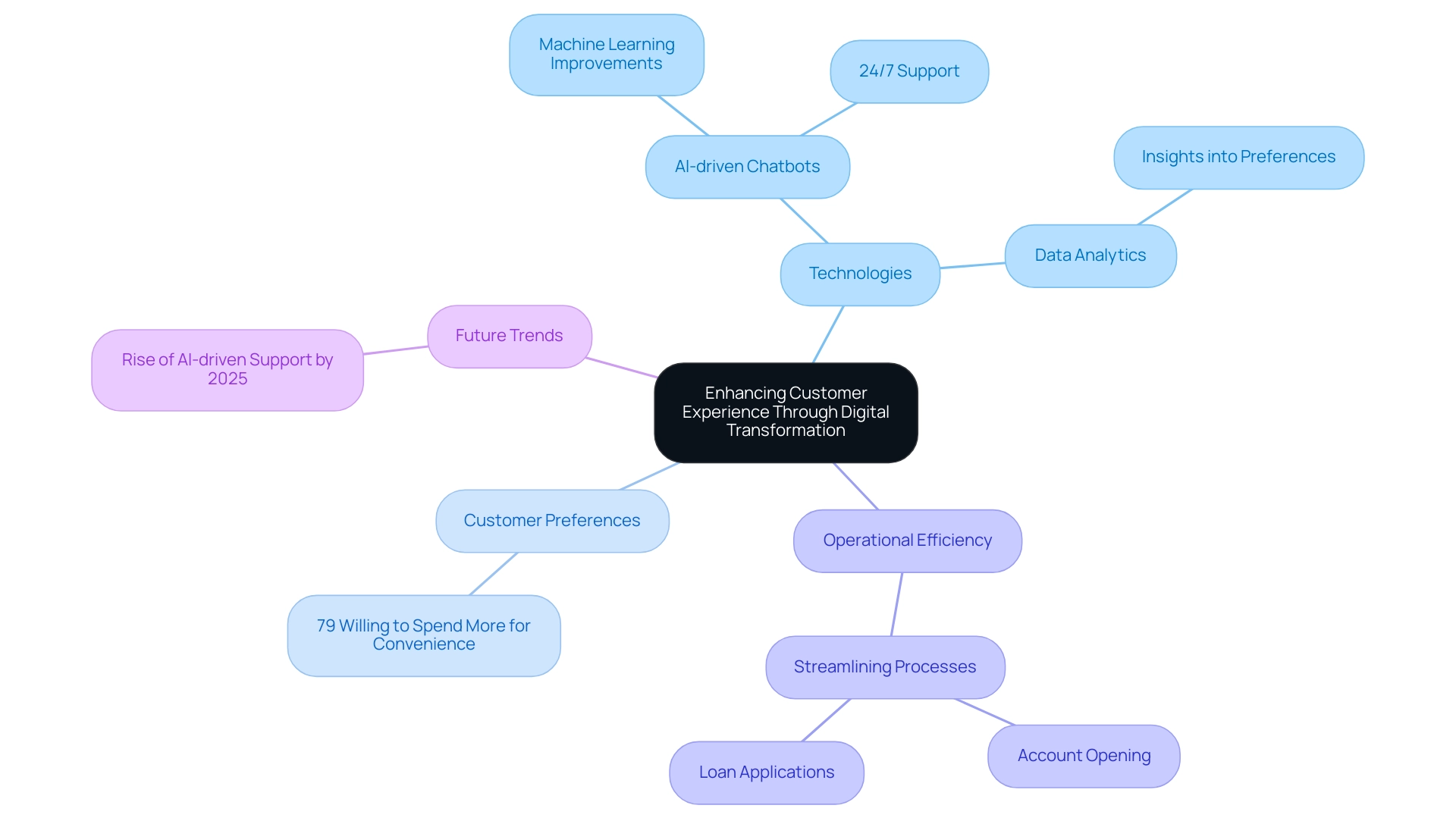
Case Studies: Successful Digital Transformation in Banking
Many financial institutions have adeptly navigated the challenges posed by technological change, providing valuable insights for banking digital transformation within the sector. A prime example is DBS Bank in Singapore, which has transformed its operations by adopting a customer-centric model and leveraging advanced technology to enhance service delivery. The establishment of a comprehensive online banking platform has not only improved client engagement but also streamlined internal processes, leading to a significant increase in client satisfaction.
Statistics reveal that banks with robust online evolution strategies experience notable enhancements in client engagement, with some projecting increases of up to 30% in client interactions by 2025. Furthermore, the transformative impact of AI is underscored by findings from NVIDIA’s 2025 State of AI in Financial Services survey, indicating that nearly 70% of firms reported at least a 5% revenue increase attributed to AI implementations. This highlights the critical importance of integrating AI into banking digital transformation strategies.
Another noteworthy case is Capital One, which has effectively harnessed the power of data analytics and artificial intelligence to tailor customer experiences and optimize operational efficiency. This strategic use of technology has enabled Capital One to maintain a competitive edge while ensuring compliance with regulatory standards—a vital aspect in the banking sector. For instance, AI tools assist financial institutions in navigating the complex regulatory landscape by automating compliance checks and monitoring transactions for adherence to regulations, thereby reducing the risk of penalties and enhancing compliance efforts.
These success stories underscore the significance of strategic planning, stakeholder involvement, and an unwavering focus on customer needs in achieving effective change through banking digital transformation. Moreover, technological change mitigates financial disintermediation, positively influencing liquidity generation—crucial for banks aiming to thrive in a competitive landscape. As Gustavo Estrada noted, “Avato streamlines complicated projects and provides outcomes within preferred timelines and budget limits,” illustrating the efficacy of integration solutions in facilitating technological advancement initiatives.
Avato’s hybrid integration platform accelerates secure system integration for banking, healthcare, and government, empowering institutions to leverage AI for enhanced customer experience and operational efficiency.
As financial institutions continue to evolve, the insights gleaned from these case studies will be instrumental in guiding future initiatives, particularly in an environment where banking digital transformation is essential for survival and growth.
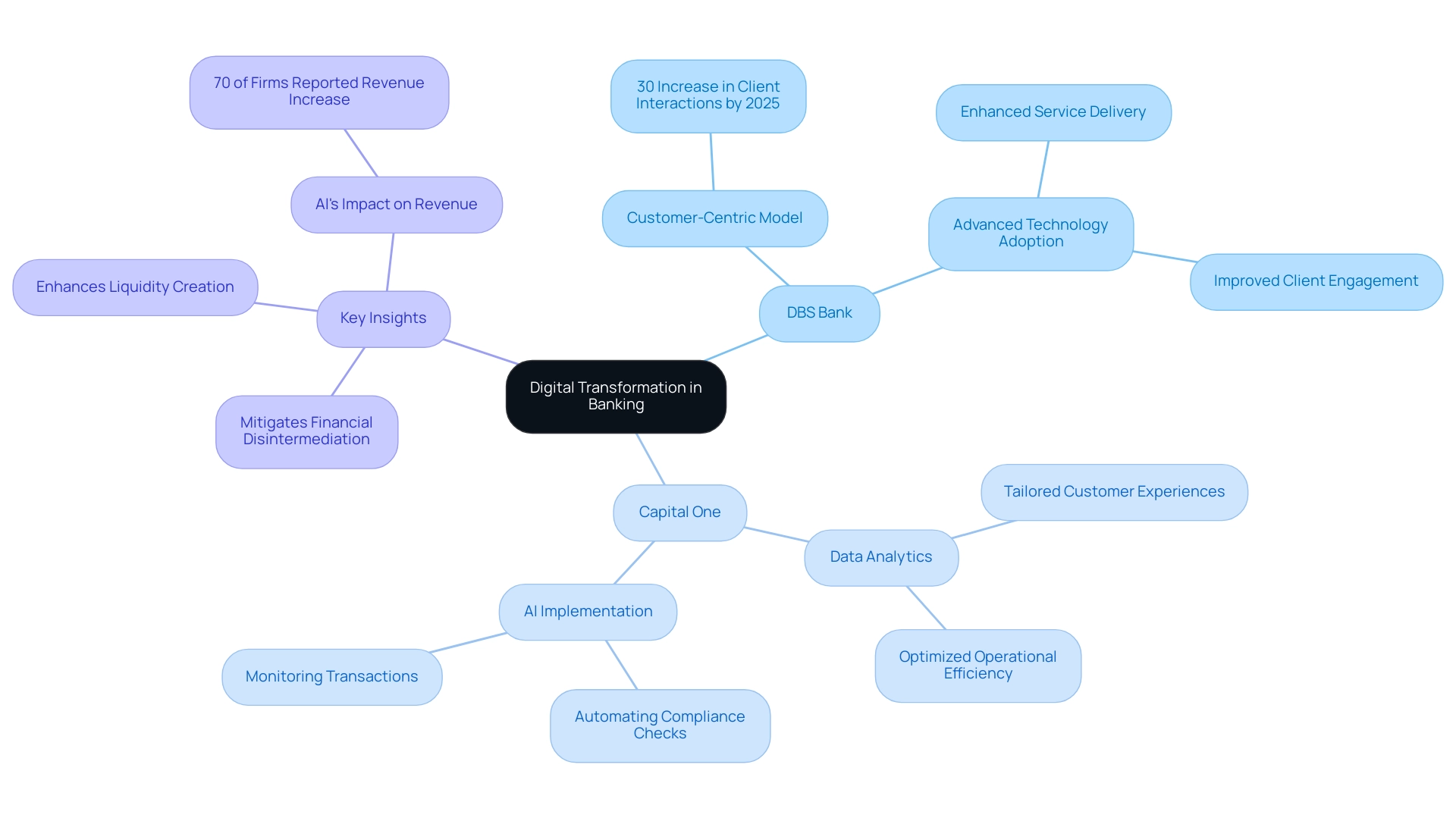
The Future of Banking: Trends Shaping Digital Transformation
The future of banking digital transformation is driven by key trends such as open banking, artificial intelligence (AI), and blockchain technology. Open banking is revolutionizing the financial landscape by enabling seamless collaboration between banks and FinTech companies. This collaboration not only promotes innovation but also significantly improves client experiences, enabling personalized financial solutions that meet individual needs.
As of 2023, nearly 46% of companies in the U.S. have begun replacing traditional passwords with biometric authentication methods, reflecting a broader shift towards more secure and user-friendly banking practices. This trend emphasizes the significance of incorporating advanced technologies in banking digital transformation to enhance security and build consumer trust.
AI is set to play an increasingly vital role in personalizing banking services and streamlining operations. By utilizing AI, financial institutions can examine client data to provide tailored products and services, thus enhancing satisfaction and loyalty. Moreover, AI-driven analytics can improve operational efficiency, enabling financial institutions to react quickly to market changes and client demands.
Significantly, generative AI has surfaced as a powerful resource in financial services, with a 60% rise in its application for user experience, especially in creating advanced chatbots and virtual assistants, along with document processing and report generation.
Avato’s hybrid integration platform is essential in enabling financial institutions to harness the full potential of generative AI. By integrating disparate systems and data, Avato empowers financial institutions to implement AI-driven solutions effectively, enhancing customer experience and operational efficiency.
Blockchain technology is another critical component reshaping the banking sector. Its inherent security and transparency features promise to revolutionize transaction processes, reducing fraud and increasing trust among stakeholders. As financial institutions adopt blockchain solutions, they can expect to see improvements in transaction speed and cost-effectiveness.
In light of these advancements, financial institutions must remain vigilant and adaptable in their banking digital transformation. Val Srinivas, a senior research leader in banking and capital markets, emphasizes that “investment in cloud migration and robust data infrastructure is essential for core systems modernization.” This investment is particularly crucial as a recent study highlighted that 22% of banking professionals view economic uncertainty as a significant barrier to implementing banking digital transformation.
Case studies reveal that financial institutions are grappling with sustainable growth amid a low-growth environment, characterized by declining net interest income and sluggish consumer loan growth. The case study titled ‘Challenges Facing Banks in a Low-Growth Environment’ illustrates that strategic decisions regarding interest income strategies and asset-liability management will be crucial for maintaining profitability in this evolving landscape. Avato’s hybrid integration solutions enable financial institutions to spearhead the AI revolution, utilizing generative AI for improved user experience and operational efficiency.
By staying informed about these emerging trends and their implications, banks can position themselves for success through banking digital transformation in an increasingly digital world, ensuring they remain competitive and responsive to customer needs.
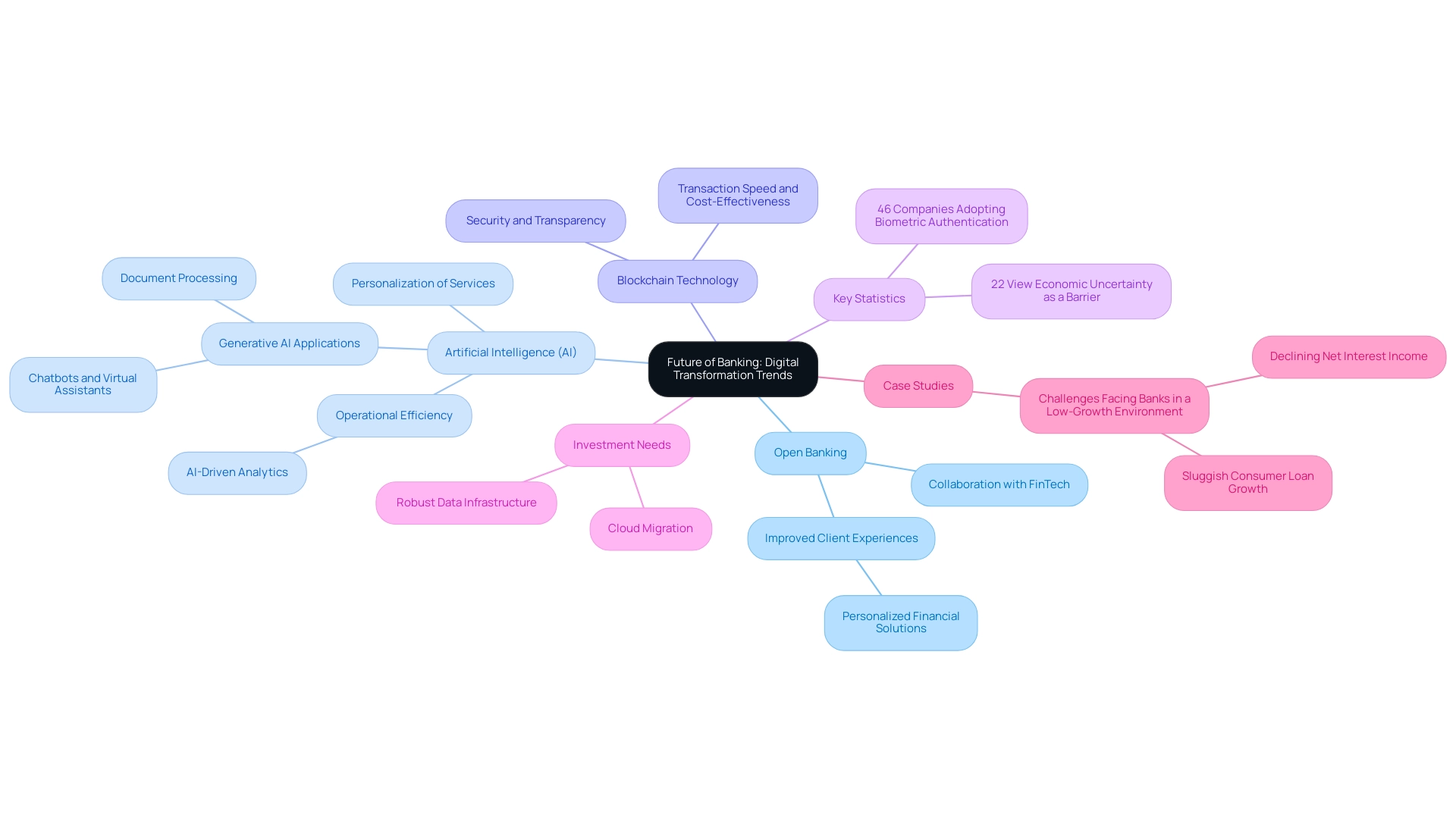
Conclusion
Digital transformation in the banking sector is not merely an option; it is an imperative journey that integrates advanced technologies to elevate customer experiences and enhance operational efficiencies. Key technologies such as artificial intelligence, cloud computing, blockchain, and robotic process automation are fundamentally reshaping how banks operate and interact with their customers. Successful case studies, including those of DBS Bank and Capital One, demonstrate how these institutions have harnessed these technologies to achieve remarkable improvements in customer engagement and satisfaction. This underscores the critical importance of strategic planning and an unwavering focus on customer needs.
As banks navigate the complexities of this ongoing transformation, collaboration across departments emerges as a vital factor for success. By fostering a culture of teamwork, banks can leverage diverse perspectives, leading to innovative solutions that address modern demands. Furthermore, tackling challenges such as outdated legacy systems and regulatory compliance necessitates a multifaceted approach, including robust stakeholder engagement and continuous adaptation to emerging trends.
Looking ahead, banks must remain vigilant and adaptable in their digital transformation efforts. With the rise of open banking, AI-driven services, and blockchain technology, the financial landscape is evolving at an unprecedented pace. Institutions that prioritize strategic investments in technology and cultivate a culture of innovation will be better positioned to thrive in this competitive environment. Ultimately, the commitment to digital transformation is not just a pathway to enhanced operational capabilities; it is a necessary evolution to meet the expectations of today’s consumers and ensure long-term success in the financial services sector.

